Change Page:
12 > | Showing page 1 of 2, messages 1 to 40 of 42 - powered by ASPPlayground.NET Forum Trial Version
Amphispur
-
Total Posts
:
417
-
Reward points
:
853
- Joined: 6/20/2012
- Location: Larkspur, Colorado, AE
|
 Breeding Journal, Species: Nerita tessellata
-
Tuesday, July 9, 2013 7:56 PM
Breeding Journal, Species: Nerita tessellata
-
Tuesday, July 9, 2013 7:56 PM
Breeding Journal DataSheet
This first post should be updated regularly to include new information as events take place or changes are made to your system General Species: Nerita tessellata Social Structure: 5 Size of Individuals: ~1-1.5" Age of Individuals: Unknown Date added to Tank: About 3 months about Broodstock Tank Details Size of Tank: 150g reef Substrate Details: Deep Sand Bed Filtration Details: 40 gallon Biological Water Changes: Annually Water Temperature: 78°F Lighting: LED's Lighting Cycle: 16 on, 8 off Other Tank Inhabitants: Various Anthias and wrasses, A pair of purple firefish, Bicolor Blenny Broodstock Feeding Details Food Types: Algae off of the wall Feeding Schedule: All the time Spawning Details Date of First Spawn: July 9, 2013 Spawn Time of Day: From 9:00 pm to 4:00 am MST Dates of Consecutive Spawns: Courtship Details: Unknown/None Seen Egg Size: Very Small, <1 mm Egg Color: White Egg Count: +1000 Hatch Details Hatch Date: July 11, 2013 Hatch Time of Day: Unknown, Most likely at night # Days after Spawn: 2 Larvae Description: Veliger, small, has an extended mouth with "eyelashes" for feeding, and a few whirls starting out for shell developement Larval Tank Details Temperature: Unknown, most likely around ~70 - 75 Size of Larval Tank: Waterbottle Substrate Details: None Other Tank Decor: None Filtration Details: None Lighting: Ambient, Sun Lighting Cycle: Ambient Water Changes: None Larval Feeding Details Food Types: Isochrysis galbana, Tetraselmis chuii Feeding Schedule: all the time Metamorphosis/Settlement Date of Settlement Start: Days after Hatch: Date of Settlement End: Description of Fry:
Grow-Out Tank Details Temperature: Size of Grow-Out Tank: Substrate Details: Other Tank Decor: Filtration Details: Lighting: Lighting Cycle: Water Changes: Size at Transfer: Age at Transfer: Grow-Out Feeding Details Food Types: Feeding Schedule: Additional Information (No Pictures or Videos in the Section Please) Miscellaneous Information: You will be required to provide photographic evidence in this thread of each event submitted for the MBI Program.
If your thread does not contain these photos the MBI Committee will not be able to approve your reports.
<message edited by Amphispur on Monday, December 16, 2013 11:15 PM>
|
|
Amphispur
-
Total Posts
:
417
-
Reward points
:
853
- Joined: 6/20/2012
- Location: Larkspur, Colorado, AE
|
 Re: Breeding Journal, Species: Nerita tessellata
-
Tuesday, July 9, 2013 7:57 PM
Re: Breeding Journal, Species: Nerita tessellata
-
Tuesday, July 9, 2013 7:57 PM
Ok so I am starting this journal just in case, and I will update it when more info is available. Right now I have a possible fry of this and I will attempt to raise it through adulthood, which I have read is around 4 months.
|
|
Amphispur
-
Total Posts
:
417
-
Reward points
:
853
- Joined: 6/20/2012
- Location: Larkspur, Colorado, AE
|
 Re: Breeding Journal, Species: Nerita tessellata
-
Sunday, July 14, 2013 4:19 PM
Re: Breeding Journal, Species: Nerita tessellata
-
Sunday, July 14, 2013 4:19 PM
Many thanks to tal, after the conference I went to the "party" he was having at his house the day afterwards. While I was there he looked at my "fry" (we had no idea what they were) and they were babies! So I will get photos up ASAP. The eggs were most likely laid sometime between the night of the 11th to the morning of the 12th. It took the eggs 2-3 days to hatch. Now I tried various methods back at my home for hatching these eggs, removing them, letting them stay, etc. With these eggs, right before I left my home for the conference I gathered 4 spawns off of my tank wall and stuck them in a water bottle. They got little to no sunlight - as little as I could while in a 2 day car drive- so that I could limit the algae growth. Also I have no fresh RO/DI on me this trip so whatever evaporates stays evaporated until I get back. After their hatch, there was close to 1000 of these guys swimming in the water, apperantly they have a pelagic phase. Now that they have hatched I will still be keeping them in the water bottle until I get home, but I am leaving it in the window for algae growth for 15 minutes and 30 minute breaks in between. This is only an experimental batch and I will be trying these guys more thoroughly when I get home and have access to algae. I will be attempting to grow them on live Isocrysis galbana algae.
<message edited by Amphispur on Monday, July 15, 2013 2:17 PM>
|
|
Amphispur
-
Total Posts
:
417
-
Reward points
:
853
- Joined: 6/20/2012
- Location: Larkspur, Colorado, AE
|
 Re: Breeding Journal, Species: Nerita tessellata
-
Sunday, July 14, 2013 4:21 PM
Re: Breeding Journal, Species: Nerita tessellata
-
Sunday, July 14, 2013 4:21 PM
This pelagic phase, in which they have, lasts until they hit meta, or other research SUGGESTS that, then they will become benthic and stay on the sand bottom. I plan on once they are benthic, if I can get this batch to last that long at least, I will add a 2" or so sand bed rinsed from my 150g display tank in which they came from.
<message edited by Amphispur on Monday, July 15, 2013 10:46 PM>
|
|
Amphispur
-
Total Posts
:
417
-
Reward points
:
853
- Joined: 6/20/2012
- Location: Larkspur, Colorado, AE
|
 Re: Breeding Journal, Species: Nerita tessellata
-
Sunday, July 14, 2013 4:31 PM
Re: Breeding Journal, Species: Nerita tessellata
-
Sunday, July 14, 2013 4:31 PM
Also, as far as detaching the eggs from the glass, I used a metal algae scraper as scrapped them off of the wall. Yes, some broke off and apart but I managed to keep around 80 to 90% of the clutches. Then I moved them to the bottle immediately afterwards via my hands. The fry are extremely small, around the size of an adult Apocyclops panamensis if not a little bit smaller.
<message edited by Amphispur on Monday, July 15, 2013 10:46 PM>
|
|
Amphispur
-
Total Posts
:
417
-
Reward points
:
853
- Joined: 6/20/2012
- Location: Larkspur, Colorado, AE
|
 Re: Breeding Journal, Species: Nerita tessellata
-
Sunday, July 14, 2013 5:15 PM
Re: Breeding Journal, Species: Nerita tessellata
-
Sunday, July 14, 2013 5:15 PM
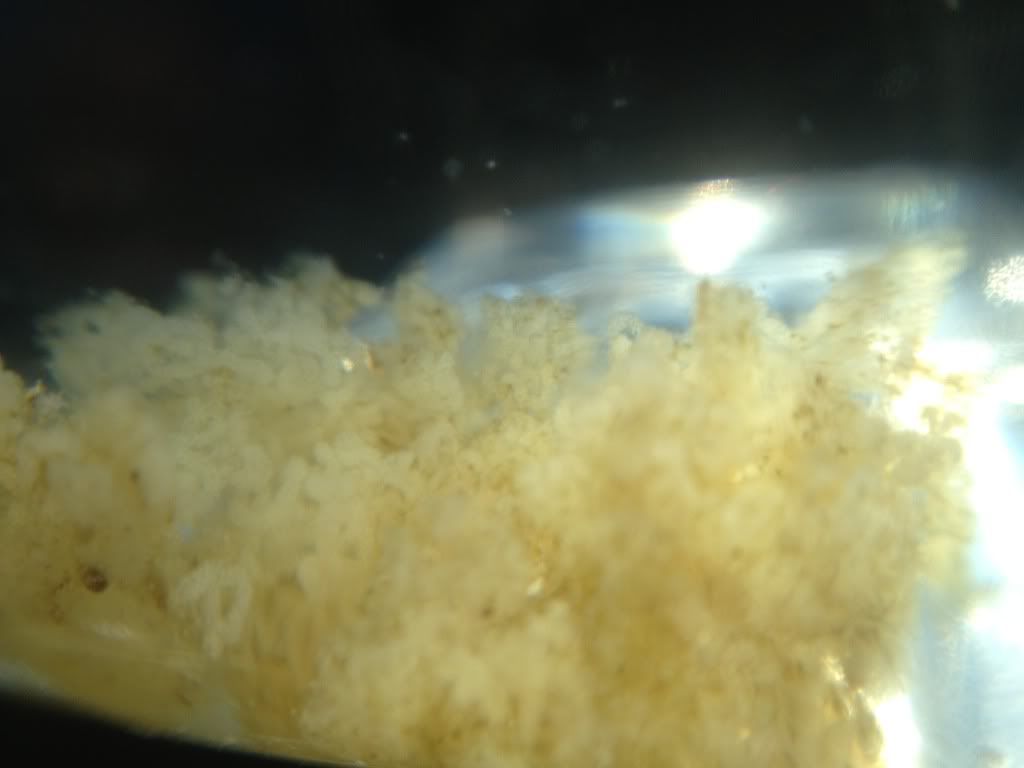 There is a photo of the egg mass. So I have a theory about their egg masses. One thing I noticed is when they are hatched, they are all nice and "white," unlike in the photo, where there was spots of black-coloration on the eggs. I theorize that these "black-colorations" are actually eggs that have hatched. They did not show up until the eggs ha hatched and the larvae were released into the water.
|
|
Amphispur
-
Total Posts
:
417
-
Reward points
:
853
- Joined: 6/20/2012
- Location: Larkspur, Colorado, AE
|
 Re: Breeding Journal, Species: Nerita tessellata
-
Sunday, July 14, 2013 7:43 PM
Re: Breeding Journal, Species: Nerita tessellata
-
Sunday, July 14, 2013 7:43 PM
Here is a photo that I hope will help understand this more, the eggs withing the black circles are eggs that are hatched, and the red circle are eggs that have not hatched yet: 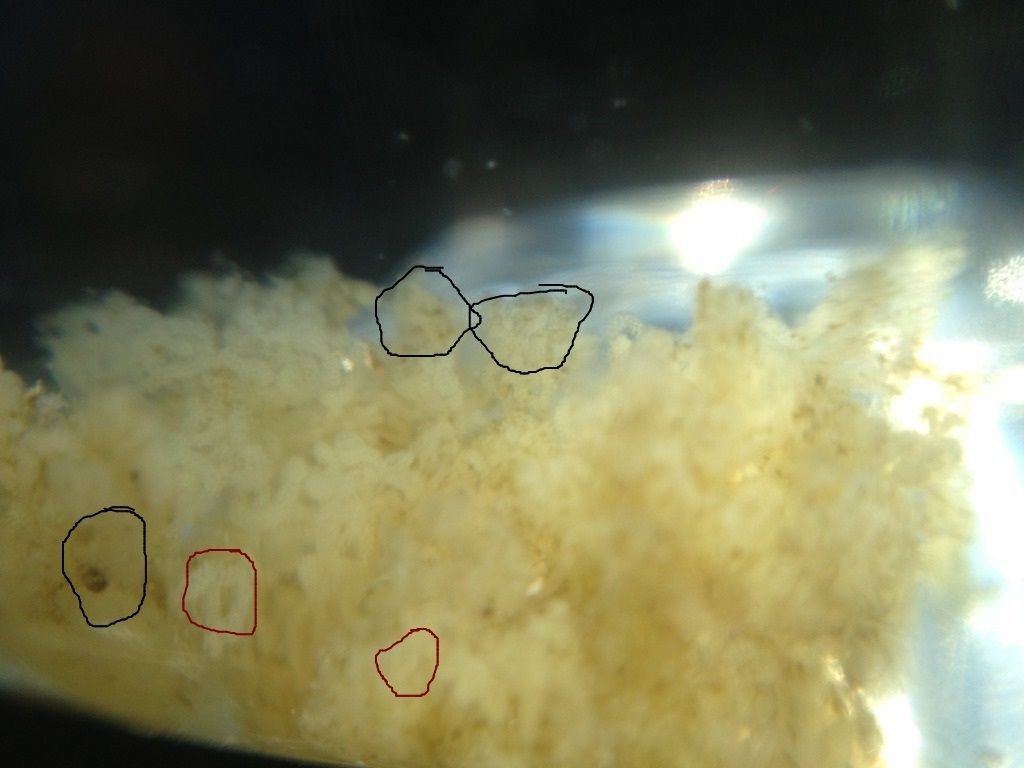
|
|
Amphispur
-
Total Posts
:
417
-
Reward points
:
853
- Joined: 6/20/2012
- Location: Larkspur, Colorado, AE
|
 Re: Breeding Journal, Species: Nerita tessellata
-
Monday, July 15, 2013 11:51 AM
Re: Breeding Journal, Species: Nerita tessellata
-
Monday, July 15, 2013 11:51 AM
As far as what I have read, not too much is known about its breeding habits and I have not seen any information about larvae of this exact species, but I have found some information about other nerite species. The only "true" and helpful site I could find was in German, and that site didn't have the exact species I am working with. But what it did tell me was that development could take anywhere from 3 weeks to 6 months depending on the outside conditions of the container it is. Also it says that "A breeding in the aquarium was not previously possible." Species first?? I am yet to find ANY information that tells of this being bred in captivity before. Here is a photo of some larvae of Neritina (Nerite) turrita, 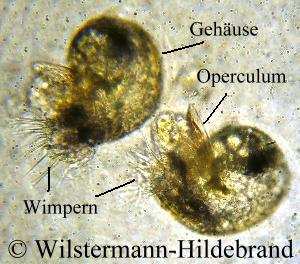 - http://www.heimbiotop.de/Neritina_turrita_Veliger2_beschr.jpg The website is in German so I translated the image, the "Wimpern" are the "eyelashes," the "Gehäuse" is the "housing," and I believe this means the outside shell and its' strength to allow support and safety for the larvae, and an operculum is "a horny plate that closes the opening of the shell when the animal is retracted.". It seems that the life cycle of this animal is somewhat similar to that of a Zebra Mussell, Dreissena polymorpha. Also, the term for the larvae of gastropods are called veliger. There are a range of veliger stages that occur while the gastropod is growing, and in these it slowly starts to have a similar shell shape to the adult gastropod. - http://el.erdc.usace.army.mil/zebra/zmis/zmishelp4/veliger_stages.htm
<message edited by Amphispur on Monday, August 5, 2013 11:46 PM>
|
|
Amphispur
-
Total Posts
:
417
-
Reward points
:
853
- Joined: 6/20/2012
- Location: Larkspur, Colorado, AE
|
 Re: Breeding Journal, Species: Nerita tessellata
-
Wednesday, July 17, 2013 3:51 PM
Re: Breeding Journal, Species: Nerita tessellata
-
Wednesday, July 17, 2013 3:51 PM
It's day 5 since the eggs have hatched and there was a MAJOR die off, only about 25-30% were alive this morning. I get back home around 6ish tonight so I will take the alive larvae and put them into a cleaner container (move them from this container, rinse it, then put new saltwater in it and the larvae back in it.) I will also be looking at the "dead" one too. There is a small possibility that these guys have actually hit their demersal stage and be going into meta. Another observation on the leftover larvae was that they were bigger than when they were hatched and from yesterday's observation as well. They have gone from less than a millimeter to around, if not a little less than, a millimeter.
|
|
Umm_fish?
-
Total Posts
:
2835
-
Reward points
:
953
- Joined: 11/4/2009
- Location: Boulder, CO, US
|
 Re: Breeding Journal, Species: Nerita tessellata
-
Wednesday, July 17, 2013 4:32 PM
Re: Breeding Journal, Species: Nerita tessellata
-
Wednesday, July 17, 2013 4:32 PM
Tell us more about your tank, please. How do you move the water? Do you add phyto? Can you share a picture?
The fact that it looks like they settled for you after only a few days in the eggs (although removal from the glass may have changed when they hatched?) and what is, presumably, a longish pelagic phase is rather remarkable. Congratulations!
--Andy, the bucket man. "Not to know the mandolin is to argue oneself unknown...." --Clara Lanza, 1886
|
|
Amphispur
-
Total Posts
:
417
-
Reward points
:
853
- Joined: 6/20/2012
- Location: Larkspur, Colorado, AE
|
 Re: Breeding Journal, Species: Nerita tessellata
-
Wednesday, July 17, 2013 4:46 PM
Re: Breeding Journal, Species: Nerita tessellata
-
Wednesday, July 17, 2013 4:46 PM
Thank you Andy! Now I'm for certain that they have hit meta, since it's a 50/50 chance ok if they are in meta or dead, but they are definitly growing within the bottle in their pelagic phase. So first I'll talk about the bottle, basicay there was nothing added, algae or rodi water, an this is somewhat of a "control." Here is a photo of the bottle:  As far as the tank the Adults are living in, the flow is a circular flow with a pump on the left side and on the right side, the pump on the left is bigger (I have no idea on the flow rates this is memory until tonight), algae in the tank, I'm not sure on the exact species, but when I started the system up I used live Isocrysis galbana, tetraselmis, and nanochloropsis. Here is a photo of that tank: 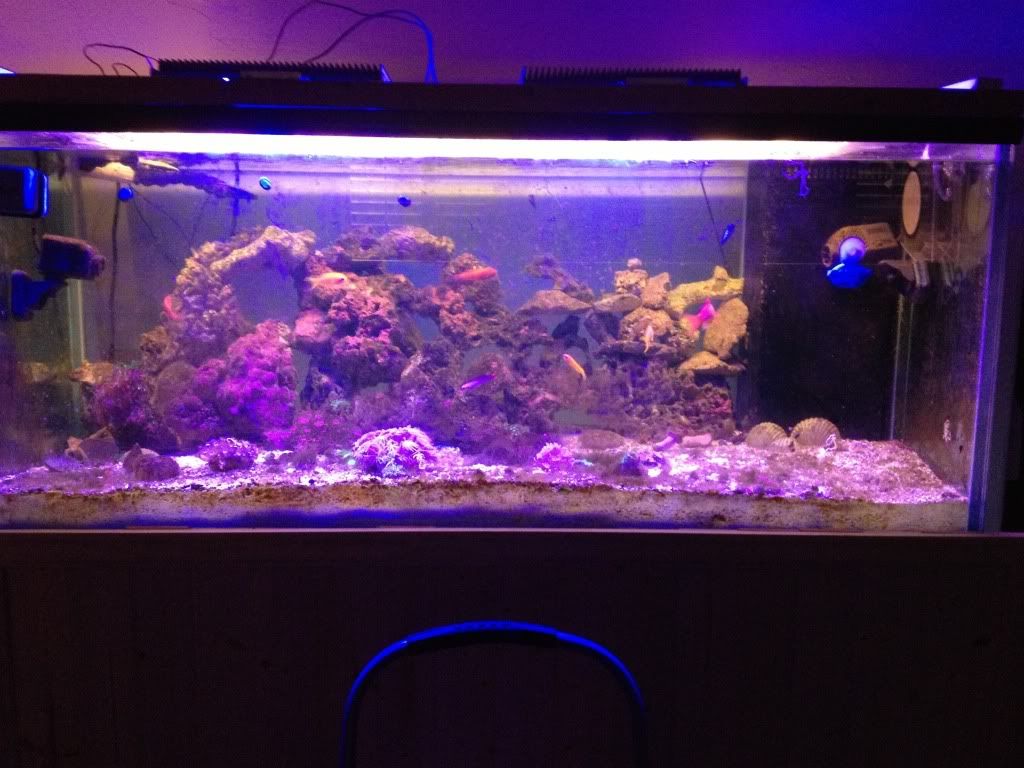
|
|
Amphispur
-
Total Posts
:
417
-
Reward points
:
853
- Joined: 6/20/2012
- Location: Larkspur, Colorado, AE
|
 Re: Breeding Journal, Species: Nerita tessellata
-
Wednesday, July 17, 2013 4:47 PM
Re: Breeding Journal, Species: Nerita tessellata
-
Wednesday, July 17, 2013 4:47 PM
Sorry, that first sentence should say NOT certain if they have hit meta or not
|
|
Umm_fish?
-
Total Posts
:
2835
-
Reward points
:
953
- Joined: 11/4/2009
- Location: Boulder, CO, US
|
 Re: Breeding Journal, Species: Nerita tessellata
-
Wednesday, July 17, 2013 9:23 PM
Re: Breeding Journal, Species: Nerita tessellata
-
Wednesday, July 17, 2013 9:23 PM
Well, _if_ they are alive in there and have settled then we'll know that they have a non-feeding (and probably short) pelagic phase. That would explain why you were successful. It would mean that they likely settle awfully small, too, given how quickly they hatched.
It would likely need to be a short pelagic phase because of the powerheads, so that would make sense.
You should move the photos of the adult and juvenile over here when you get the chance.
--Andy, the bucket man. "Not to know the mandolin is to argue oneself unknown...." --Clara Lanza, 1886
|
|
Umm_fish?
-
Total Posts
:
2835
-
Reward points
:
953
- Joined: 11/4/2009
- Location: Boulder, CO, US
|
 Re: Breeding Journal, Species: Nerita tessellata
-
Wednesday, July 17, 2013 9:25 PM
Re: Breeding Journal, Species: Nerita tessellata
-
Wednesday, July 17, 2013 9:25 PM
And I just want to go ahead and add, a short pelagic phase makes sense, too, from the way the adult's shell is formed.
--Andy, the bucket man. "Not to know the mandolin is to argue oneself unknown...." --Clara Lanza, 1886
|
|
Amphispur
-
Total Posts
:
417
-
Reward points
:
853
- Joined: 6/20/2012
- Location: Larkspur, Colorado, AE
|
 Re: Breeding Journal, Species: Nerita tessellata
-
Wednesday, July 17, 2013 9:49 PM
Re: Breeding Journal, Species: Nerita tessellata
-
Wednesday, July 17, 2013 9:49 PM
Well Andy, not out of the woods yet  still in their larval stage, just got home and looked under the microscope. Still very much alive though which is a relief. What's not a relief is that they were invaded! Saw a rotifer or something in it as well... Hopefully all will go well. So now, I will be siphoning up the larvae and doing my "remix" into a fresh new water bottle with new saltwater.
|
|
Amphispur
-
Total Posts
:
417
-
Reward points
:
853
- Joined: 6/20/2012
- Location: Larkspur, Colorado, AE
|
 Re: Breeding Journal, Species: Nerita tessellata
-
Wednesday, July 17, 2013 10:24 PM
Re: Breeding Journal, Species: Nerita tessellata
-
Wednesday, July 17, 2013 10:24 PM
Ok so here are some videos and pics of the fry. The first two videos are one's that Tal took at his place (Thanks Tal!) And the third is mine. That video and the picture were taken 20 minutes ago! 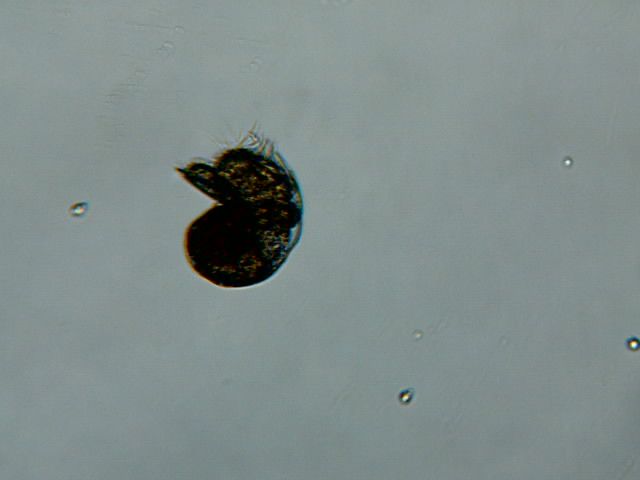
|
|
Amphispur
-
Total Posts
:
417
-
Reward points
:
853
- Joined: 6/20/2012
- Location: Larkspur, Colorado, AE
|
 Re: Breeding Journal, Species: Nerita tessellata
-
Wednesday, July 17, 2013 10:29 PM
Re: Breeding Journal, Species: Nerita tessellata
-
Wednesday, July 17, 2013 10:29 PM
|
|
Amphispur
-
Total Posts
:
417
-
Reward points
:
853
- Joined: 6/20/2012
- Location: Larkspur, Colorado, AE
|
 Re: Breeding Journal, Species: Nerita tessellata
-
Wednesday, July 17, 2013 10:29 PM
Re: Breeding Journal, Species: Nerita tessellata
-
Wednesday, July 17, 2013 10:29 PM
|
|
Amphispur
-
Total Posts
:
417
-
Reward points
:
853
- Joined: 6/20/2012
- Location: Larkspur, Colorado, AE
|
 Re: Breeding Journal, Species: Nerita tessellata
-
Wednesday, July 17, 2013 10:58 PM
Re: Breeding Journal, Species: Nerita tessellata
-
Wednesday, July 17, 2013 10:58 PM
Ok they are in the same bottle now, just with fresher water and some live Isocrysis.
|
|
Umm_fish?
-
Total Posts
:
2835
-
Reward points
:
953
- Joined: 11/4/2009
- Location: Boulder, CO, US
|
 Re: Breeding Journal, Species: Nerita tessellata
-
Saturday, August 3, 2013 7:57 PM
Re: Breeding Journal, Species: Nerita tessellata
-
Saturday, August 3, 2013 7:57 PM
How are these guys doing?
--Andy, the bucket man. "Not to know the mandolin is to argue oneself unknown...." --Clara Lanza, 1886
|
|
Amphispur
-
Total Posts
:
417
-
Reward points
:
853
- Joined: 6/20/2012
- Location: Larkspur, Colorado, AE
|
 Re: Breeding Journal, Species: Nerita tessellata
-
Monday, August 5, 2013 2:08 PM
Re: Breeding Journal, Species: Nerita tessellata
-
Monday, August 5, 2013 2:08 PM
Well the first batch did not make it Andy, I don't know when they died, but it was probably after a week of me getting back from the conference trip (one or two weeks ago.) But what I did is I got another batch just yesterday, I don't know when the eggs were laid, but they were on the glass so I collected them. One thing that I have noticed, is that these egg spawns, on the glass, look close to IDENTICAL with those of a cerith snail's, when on the glass at least. Another thing that I had noticed, with the last batch especially, is that after they died off, I could not find any Isochrysis algae at all in the bottle, so I can assume that they are feeding on it. Before these eggs had hatched (yesterday) I had put in around 1/2 a mason jar full of Isochrysis into the container, which pretty much means I filled the bottle with algae, just to see what happened. Will the algae grow on the eggs and not let them hatch? Will the algae get onto the eggs and kill the fry? Were just a few of the questions I wanted to find answers to. Both answers were a big NO. I looked into the bottle a few minutes ago and saw hundreds, maybe even THOUSANDS of these fry swimming in the water column. I'm going to try this method and see what happens, it is similar to my last attempt, but this time there is much more Isochrysis algae in the water. Here is a photo of the larvae yesterday (first pic) taken at around 4 or 5pm MSD and a photo of them today, taken a few minutes ago (second pic)  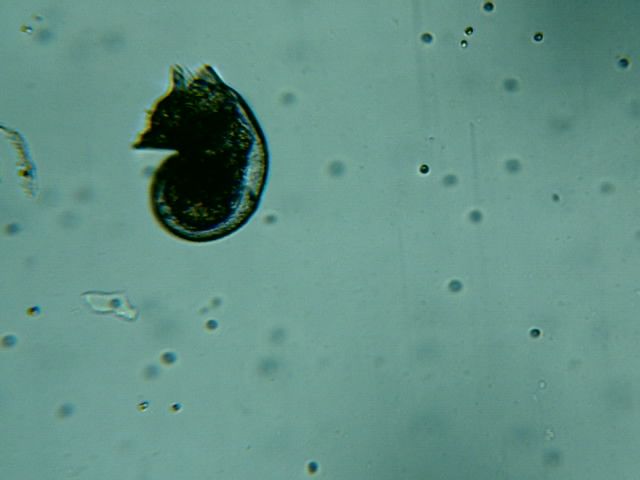
|
|
Amphispur
-
Total Posts
:
417
-
Reward points
:
853
- Joined: 6/20/2012
- Location: Larkspur, Colorado, AE
|
 Re: Breeding Journal, Species: Nerita tessellata
-
Tuesday, August 6, 2013 8:51 AM
Re: Breeding Journal, Species: Nerita tessellata
-
Tuesday, August 6, 2013 8:51 AM
Today I seem to be finding a mix of these guys, some look like the bottom photo from above, and the rest look like this: 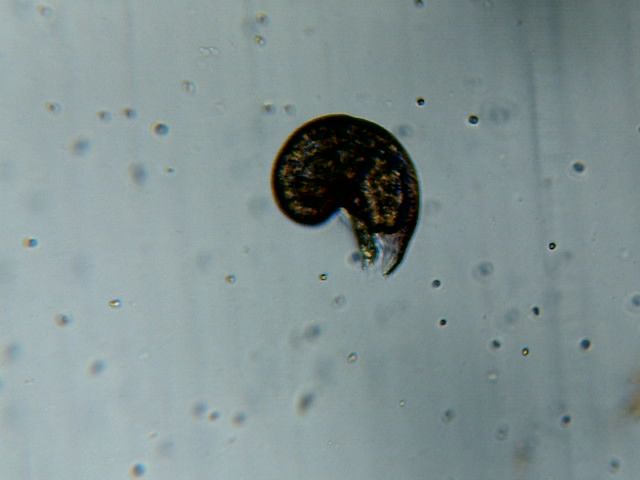 With the second, they move slower, and also do not do the "spining" feeding tactic anymore, which is one thing I noticed yesterday. This "spinning" feeding occured as follows: Larvae spins in circles, from slow to fast, making a small vortex in the process, bringing the algae to the larvae. Is the next stage of these guys? Or are they just starving?? It also seems like this one has two whirls on it, but looking at the second photo before it seems that had two whirls to! - Strike that, only some of the larvae do that, which I presume are the unhealthy/dying ones. Here is a video (hard to tell which stage it is, but it is infact a stage 2 of these guys) on them feeding on Isochrysis: It starts at around 15 seconds when the feeding behavior begins
|
|
Umm_fish?
-
Total Posts
:
2835
-
Reward points
:
953
- Joined: 11/4/2009
- Location: Boulder, CO, US
|
 Re: Breeding Journal, Species: Nerita tessellata
-
Tuesday, August 6, 2013 10:14 AM
Re: Breeding Journal, Species: Nerita tessellata
-
Tuesday, August 6, 2013 10:14 AM
Okay, hard question: Keep an eye out for these guys dying of starvation. If you suspect that you might want to start thinning them out early. It's tough to do, but fewer larvae might mean that more survive if you are constantly running short of Iso.
I'll go watch your movie now....
--Andy, the bucket man. "Not to know the mandolin is to argue oneself unknown...." --Clara Lanza, 1886
|
|
Umm_fish?
-
Total Posts
:
2835
-
Reward points
:
953
- Joined: 11/4/2009
- Location: Boulder, CO, US
|
 Re: Breeding Journal, Species: Nerita tessellata
-
Tuesday, August 6, 2013 10:17 AM
Re: Breeding Journal, Species: Nerita tessellata
-
Tuesday, August 6, 2013 10:17 AM
The movie snail certainly looks happy. I think Iso is a winner for them.
--Andy, the bucket man. "Not to know the mandolin is to argue oneself unknown...." --Clara Lanza, 1886
|
|
Amphispur
-
Total Posts
:
417
-
Reward points
:
853
- Joined: 6/20/2012
- Location: Larkspur, Colorado, AE
|
 Re: Breeding Journal, Species: Nerita tessellata
-
Tuesday, August 6, 2013 10:32 AM
Re: Breeding Journal, Species: Nerita tessellata
-
Tuesday, August 6, 2013 10:32 AM
Yes, the one in the vid was one of a few that I found like that swimming. Only a few didn't eat and those I just through out after looking at them for a little bit. I'll probably do more and thin out more as they start dying. Although I don't think I'll be running short on Iso anytime soon. Got another 5 mason jars full just waiting to be used on something! Question for you Andy, comparing the first picture to the second, in the second picture the "mouth" is more elongated and skinnier with part of the "shell?" Growing next to it. Is this correct?
|
|
Amphispur
-
Total Posts
:
417
-
Reward points
:
853
- Joined: 6/20/2012
- Location: Larkspur, Colorado, AE
|
 Re: Breeding Journal, Species: Nerita tessellata
-
Tuesday, August 6, 2013 5:54 PM
Re: Breeding Journal, Species: Nerita tessellata
-
Tuesday, August 6, 2013 5:54 PM
So, Andy, as you stated before, the topic of how to do the dead/dying snails. I have attempted a method that might work. What I do is split the water from the "mother container" into around 7 containers (wine testers that Jim graciously gave me) and that leaves just a small amount on the bottom of the container which holds the dead/egg mass. Then I empty that out and rinse it with fresh RO/DI water. 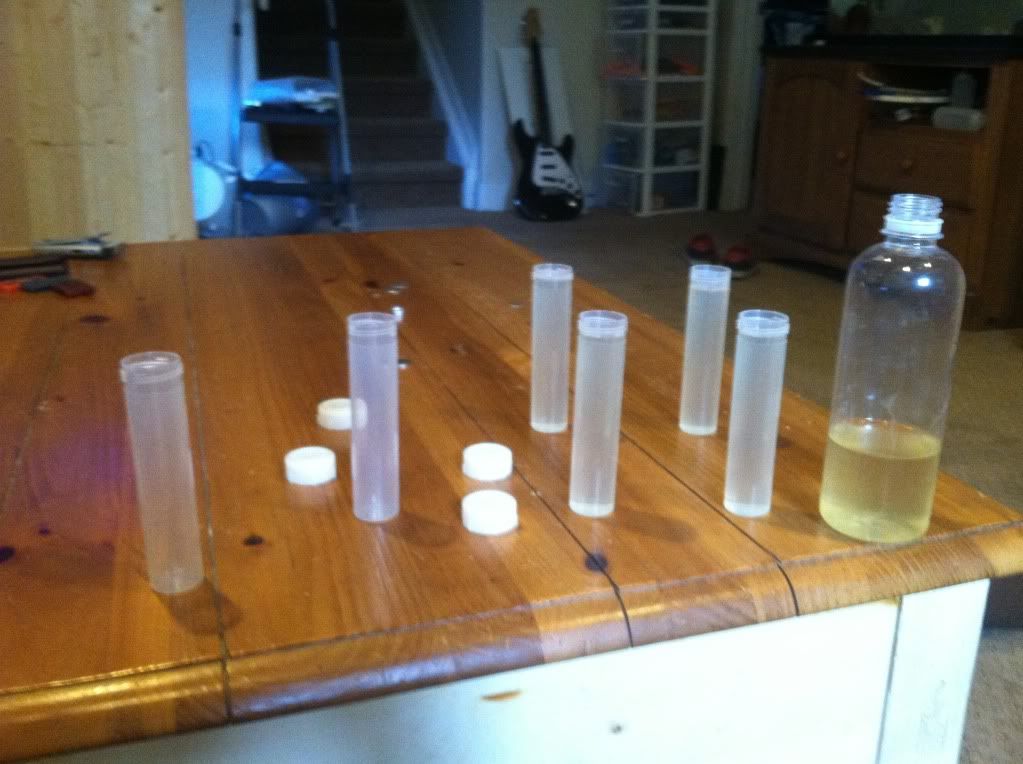 I'll be doing this every day from now on, for the first two weeks. Then, after that (since it is their estimated starvation period) I will be doing the "water changes" once a week.
|
|
Umm_fish?
-
Total Posts
:
2835
-
Reward points
:
953
- Joined: 11/4/2009
- Location: Boulder, CO, US
|
 Re: Breeding Journal, Species: Nerita tessellata
-
Tuesday, August 6, 2013 7:00 PM
Re: Breeding Journal, Species: Nerita tessellata
-
Tuesday, August 6, 2013 7:00 PM
 Originally Posted by Question for you Andy, comparing the first picture to the second, in the second picture the "mouth" is more elongated and skinnier with part of the "shell?" Growing next to it. Is this correct? The truth is, the soft body of the snail is able to change shape enormously. No telling what the "real" shape is supposed to be. (Was that your question?)
 Originally Posted by wine testers that Jim graciously gave me Is that what those are? I love those things. Best shipping containers ever. I was really talking about the possibility of culling the live snails if you see that having too many in your culture is inhibiting the whole bunch. Invert scientists do this all the time so they can concentrate their time/energy/water quality into fewer larvae, hopefully improving the possibility of getting more through in the end.
--Andy, the bucket man. "Not to know the mandolin is to argue oneself unknown...." --Clara Lanza, 1886
|
|
Amphispur
-
Total Posts
:
417
-
Reward points
:
853
- Joined: 6/20/2012
- Location: Larkspur, Colorado, AE
|
 Re: Breeding Journal, Species: Nerita tessellata
-
Tuesday, August 6, 2013 8:15 PM
Re: Breeding Journal, Species: Nerita tessellata
-
Tuesday, August 6, 2013 8:15 PM
Ah that makes sense. Besides culling, I think this is killing, tell me if I'm wrong here, but could I also just split the cultures into the wine testers then A.) work them in the cultures, or B.) Split them into more algae containers. Also, I understand the concept of them changing into different shapes, but how rare would it be that after 2-3 days most are all the EXACT same shape? I'm thinking this is one of their benthic larval stages that they turn in to, obviously I'd have to run a few more sets of eggs (when I get more, they are not in the mood anymore!) just to make sure that these are larval stages I'm seeing and not just them moving and morphing into shapes they wanna be in.
<message edited by Amphispur on Tuesday, August 6, 2013 9:13 PM>
|
|
Umm_fish?
-
Total Posts
:
2835
-
Reward points
:
953
- Joined: 11/4/2009
- Location: Boulder, CO, US
|
 Re: Breeding Journal, Species: Nerita tessellata
-
Tuesday, August 6, 2013 9:08 PM
Re: Breeding Journal, Species: Nerita tessellata
-
Tuesday, August 6, 2013 9:08 PM
Yes, culling is killing. Consider, though, that in a snail pair's life they average getting two successful progeny to adulthood. (I say this because reef censuses over the years show that population figures are surprisingly stable for most species. In other words, most animals roughly manage to replace themselves over the course of their reproductive lifespans. And that's it.) So if you get twenty to adulthood, those genes have already been enormously successful by comparison with norms in the wild. And twenty is much, much better than zero.
I'm not telling you to cull them. You have to make that decision. But, if you run low on food and/or water quality and/or time and/or space, do consider it.
The next stage that you want them to go through (that you'll be able to see) is where those two big, ciliated lobes pull together and merge to become the snails' feeding appendage (trunk, snout, whatever). If you still see the cilia then they haven't gone through it yet. That change is pretty much the equivalent of fishes' meta. After that point, the snail has no real way to move around in the water column (since the cilia are gone) and pretty much better be benthic at that point. That's your big cue. So long as you still see the cilia they still need phyto.
--Andy, the bucket man. "Not to know the mandolin is to argue oneself unknown...." --Clara Lanza, 1886
|
|
Amphispur
-
Total Posts
:
417
-
Reward points
:
853
- Joined: 6/20/2012
- Location: Larkspur, Colorado, AE
|
 Re: Breeding Journal, Species: Nerita tessellata
-
Tuesday, August 6, 2013 9:12 PM
Re: Breeding Journal, Species: Nerita tessellata
-
Tuesday, August 6, 2013 9:12 PM
Ah ok thanks! So as soon as cilia is gone, they don't need phyto and are settled. So even when the shell is growing, and the cilia is merging, would it stay merged and still be cilia for a few days possibly? such as they run around with an almost merged cilia for awhile? Thanks for all the info Andy, it really helps!
|
|
Umm_fish?
-
Total Posts
:
2835
-
Reward points
:
953
- Joined: 11/4/2009
- Location: Boulder, CO, US
|
 Re: Breeding Journal, Species: Nerita tessellata
-
Tuesday, August 6, 2013 9:31 PM
Re: Breeding Journal, Species: Nerita tessellata
-
Tuesday, August 6, 2013 9:31 PM
The times I've seen it, it's a pretty quick transition. But I wasn't watching planktonic veligers. Here's the story, though:
 Originally Posted by In many species, induction of metamorphosis occurs as a sensory response to a chemical cue indicative of the juvenile and/or adult habitat. Often this cue (the inducer) is a water soluble chemical secreted by the adult food. Induction of metamorphosis results in the larva settling to the substratum. This settlement may be followed by a "searching" phase as the larva apparently looks for an appropriate place to metamorphose. When metamorphosis occurs, the velum is lost, and the newly metamorphosed juvenile adopts its slug-like adult form. http://en.wikipedia.org/wiki/Veliger Basically, the larvae has found food and now it's time to eat. So they pretty quickly develop the ability. And that is, of course, when they really start putting on the growth.
--Andy, the bucket man. "Not to know the mandolin is to argue oneself unknown...." --Clara Lanza, 1886
|
|
Amphispur
-
Total Posts
:
417
-
Reward points
:
853
- Joined: 6/20/2012
- Location: Larkspur, Colorado, AE
|
 Re: Breeding Journal, Species: Nerita tessellata
-
Tuesday, August 6, 2013 9:56 PM
Re: Breeding Journal, Species: Nerita tessellata
-
Tuesday, August 6, 2013 9:56 PM
Ah ok thanks! Well that sounds like an interesting experiment for me to try out! I'm thinking of putting in macroalgae into a container, and one of the parents. Since it has to do with a chemical done by either the parents or the young/
|
|
Umm_fish?
-
Total Posts
:
2835
-
Reward points
:
953
- Joined: 11/4/2009
- Location: Boulder, CO, US
|
 Re: Breeding Journal, Species: Nerita tessellata
-
Tuesday, August 6, 2013 10:00 PM
Re: Breeding Journal, Species: Nerita tessellata
-
Tuesday, August 6, 2013 10:00 PM
Yeah. Whatever it is that the parents will eat, whether that means scraping the walls of the aquarium or whatever. It helps that the parents often get the algae growing right on their shells.
At some point, though, you should try to get them to meta without going through all that. Some don't seem to need the cue (or it's from something common that'll show up on the wall of your rearing vessel any way).
--Andy, the bucket man. "Not to know the mandolin is to argue oneself unknown...." --Clara Lanza, 1886
|
|
Amphispur
-
Total Posts
:
417
-
Reward points
:
853
- Joined: 6/20/2012
- Location: Larkspur, Colorado, AE
|
 Re: Breeding Journal, Species: Nerita tessellata
-
Tuesday, August 6, 2013 10:16 PM
Re: Breeding Journal, Species: Nerita tessellata
-
Tuesday, August 6, 2013 10:16 PM
That test, the "control" if one could say, is what I am doing right now. If I get anymore spawns out of these guys, I'll expand and try different cues and see if those work faster/better.
|
|
Amphispur
-
Total Posts
:
417
-
Reward points
:
853
- Joined: 6/20/2012
- Location: Larkspur, Colorado, AE
|
 Re: Breeding Journal, Species: Nerita tessellata
-
Tuesday, August 6, 2013 10:38 PM
Re: Breeding Journal, Species: Nerita tessellata
-
Tuesday, August 6, 2013 10:38 PM
Andy, would these larvae be Veliger or Trochophore? I'm a little confused on what a trochophore is compared to a veliger, it seems as though these are mostly the same?
|
|
Amphispur
-
Total Posts
:
417
-
Reward points
:
853
- Joined: 6/20/2012
- Location: Larkspur, Colorado, AE
|
 Re: Breeding Journal, Species: Nerita tessellata
-
Tuesday, August 6, 2013 10:39 PM
Re: Breeding Journal, Species: Nerita tessellata
-
Tuesday, August 6, 2013 10:39 PM
Disregard that last post, all the difference is is just the families 
|
|
Umm_fish?
-
Total Posts
:
2835
-
Reward points
:
953
- Joined: 11/4/2009
- Location: Boulder, CO, US
|
 Re: Breeding Journal, Species: Nerita tessellata
-
Tuesday, August 6, 2013 10:45 PM
Re: Breeding Journal, Species: Nerita tessellata
-
Tuesday, August 6, 2013 10:45 PM
Trochophores are an earlier stage. These are definitely veligers. This is what a trochophore looks like: 
--Andy, the bucket man. "Not to know the mandolin is to argue oneself unknown...." --Clara Lanza, 1886
|
|
Amphispur
-
Total Posts
:
417
-
Reward points
:
853
- Joined: 6/20/2012
- Location: Larkspur, Colorado, AE
|
 Re: Breeding Journal, Species: Nerita tessellata
-
Tuesday, August 6, 2013 10:49 PM
Re: Breeding Journal, Species: Nerita tessellata
-
Tuesday, August 6, 2013 10:49 PM
Ah, ok thanks Andy!
|
|
Umm_fish?
-
Total Posts
:
2835
-
Reward points
:
953
- Joined: 11/4/2009
- Location: Boulder, CO, US
|
 Re: Breeding Journal, Species: Nerita tessellata
-
Tuesday, August 6, 2013 10:53 PM
Re: Breeding Journal, Species: Nerita tessellata
-
Tuesday, August 6, 2013 10:53 PM
Sure. Yeah, trochophores are basically just bags with mouths. Way the heck early development.
--Andy, the bucket man. "Not to know the mandolin is to argue oneself unknown...." --Clara Lanza, 1886
|
|
Amphispur
-
Total Posts
:
417
-
Reward points
:
853
- Joined: 6/20/2012
- Location: Larkspur, Colorado, AE
|
 Re: Breeding Journal, Species: Nerita tessellata
-
Saturday, September 14, 2013 6:43 PM
Re: Breeding Journal, Species: Nerita tessellata
-
Saturday, September 14, 2013 6:43 PM
Well, it seems throughout this whole mess I've forgotten a BIG thing (Thanks Matt!) the PARENTS! Here is the only one I could get NOT hiding in the rocks: 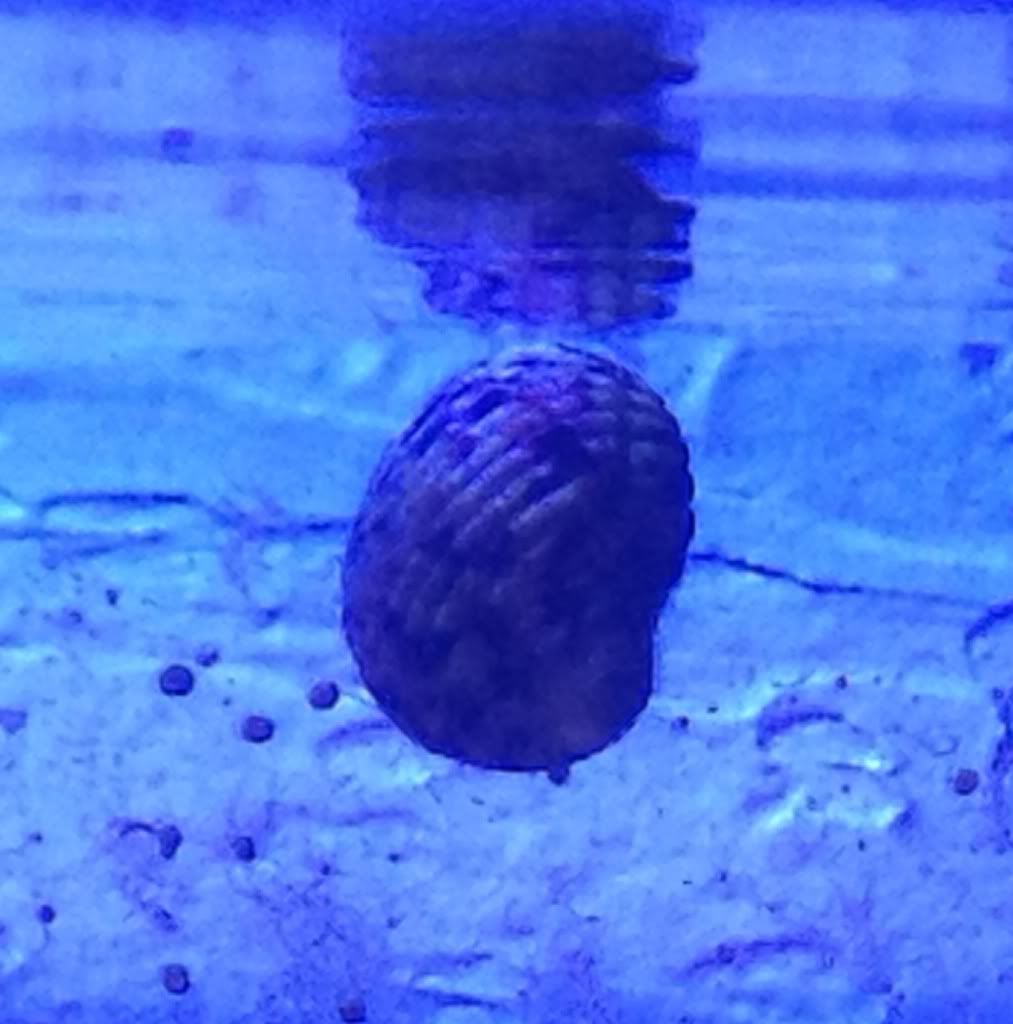
|
|